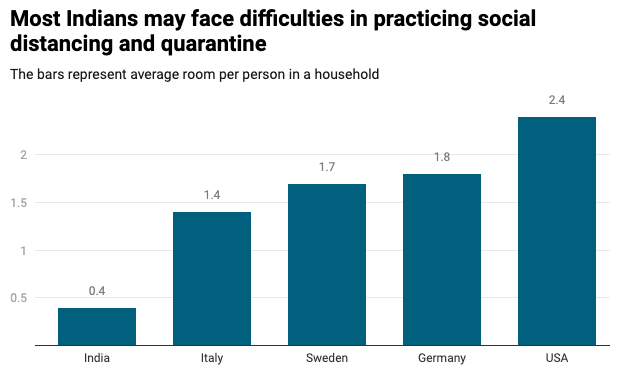
Vivek*, a 26 year old professional from Delhi, has been advised for a 14 day home quarantine against Covid 19 infection by the government officials. He was in contact with an infected person but his test was negative. Vivek lives in a 3200 square feet house with a family of four (including himself). He told Govern that he has confined himself to his personal room due to safety reasons.
While Vivek is able to follow social distancing and quarantine norms properly, millions of Indians might not be able to do so. The average room per person in Indian household is just 0.4, according to analysis of latest government data; compared to 2.4 in the US, the country with the maximum COVID 19 infections as on 10th April 2020, The lack of adequate space in Indian households as compared to their western counterparts could potentially be a barrier towards fighting Coronavirus successfully in India. About 900 million Indians, or nearly 75% of India’s households—with an average family size of five— live in two rooms or less. Of 900 million people living in two rooms or less, 630 million, or more than half of all households, live in rural areas, with 262 million, or 20%, in urban areas.
The social distancing policy is a “non-pharmaceutical infection prevention and control intervention” implemented to mitigate the community transmission in India, according to the Ministry of Health and Family Welfare. However, compared to western countries, India struggles to meet the basic needs of housing as per available data. The World Health Organization has released a set of recommendations for practicing quarantine. For home quarantine, it recommends that the person should occupy a well-ventilated single room, or if a single room is not available, maintain a distance of at least 1 metre from other household members, minimize the use of shared spaces and cutlery, and ensure that shared spaces (such as the kitchen and bathroom) are well ventilated. While Vivek’s house satisfies these recommendations, it is clear that most Indians will not be able to do so if required.
Govern spoke to experts and residents in multiple countries and found that the idea of social distancing is more complex than it appears to be.
“Compared to the rest of Europe, India as a South-Asian country suffers from lack of adequate space to accomplish something like social distancing in the periods of home quarantine,” Roshni Kumar, a researcher who works on urban planning in Delhi tells Govern .
India has the lowest availability of rooms per person

India: Average Household Size. 4.8,
Note: The figure of 0.4 for India is an estimate as not of 70% Indians, not everyone will be in a 2 room settlement. However, the core argument remains the same i.e. Indians have lack of space to practice social distancing and quarantine, if needed.
Anant Bhan, a researcher in global health & bioethics, agrees, “It will be a problem for those who have to quarantine in their houses if they are infected/suspect but not a problem for healthy people. If a person is potentially infected, they could infect everyone else in the family too.”
Social Norms and Class barriers against Social distancing
Aqueel Khan, who is the Area Magistrate, Jaipur, spoke to Govern about the challenges faced by the urban poor when it comes to social distancing. “There is an area called Ramganj in Jaipur where there have been 93 positive cases in a radius of 100 meters. There is a jewellery factory, which is housing 60-70 people (workers and their families) spread across 6-7 rooms. These people eat, sleep and sit in the same room.” However, given the social norms, a man cannot sit with his daughter-in-law all day in the same room. “Even the terrace of the building is too small to cater to such large families. Hence, these people may not be able to practice social distancing and isolation due to space constraints and social norms.” Khan adds that while these people understand the gravity of the situation, fully practicing social distancing will be comparatively challenging for them.
Bhan suggests that “for poor families, I think the government should offer quarantine facilities. The concept of social distancing is more for middle class and upper middle class families”. This could be a potential solution, which has been adopted in multiple countries. For instance, in San Francisco, city officials have shifted homeless persons to shelters and empty hotels. Similar plans have been in place in UK and Germany, as well.
India has the harshest lockdown in the world
|
Name of the country |
Lockdown Policy |
Explanation of the policy |
|
Sweden |
No Lockdown |
Sweden is among the few European nations with no lockdown policy as of now. There are restrictions on gathering of 50 people or now. However, the schools are open for children under 16 without any movement restrictions. According to the latest guidelines by Swedish Public Health Agency, larger contexts should be avoided such as parties, weddings. Distanciation has been advised in public spaces like gyms, parks, shopping malls. These guidelines are only recommended and there are no official sanctions if people don’t abide by these. |
|
USA |
Different For Every State |
The US government has made recommendations and advisories but they are not mandatory. The federal states, however, have implemented their own restrictions and lockdowns, and it varies in each state. |
|
Germany |
Restricted |
The German government has undertaken social distancing measures on 22nd March and has been extended till 19th April. The social distancing measures bans public gatherings of more than two people, restaurants, hair salons, tattoo parlors have been closed down. Schools across the country have been shut down. Apart from allowing for operation of essential services, the government has allowed Germans to go out and exercise with a distance of 1.5 meters between them. |
|
Italy |
Yes |
Italy’s lockdown policy was first imposed till 3 April and has been extended thereafter. The country has been put under complete lockdown ever since March 10 closing down schools, universities, gyms, movie theatres, and religious places. The travel ban and lockdown is being enforced with the help of military police, railway police and healthy authority workers. Under the complete lockdown policy, Italians can access essential services such as that of groceries and medicines and violations are punished by the police. |
|
India |
Yes |
Announced on 24th March, 2020 By PM Narendra Modi India’s lockdown policy is the biggest lockdown policy for 1.3 billion Indians to stay home for 21 days. The announcement comes in the wake of the global pandemic covid-19 and to contain its spread. The complete lockdown policy allows for operation of essential, emergency services such as grocery shops, pharmacies and banks. The lockdown centrally shuts down the travel to and fro the workplace, or the places of leisure. According to the rules provided by the Home Affairs Ministry, any violation would impose a fine of Rs. 200 |
Sources: India; Italy; Germany; Sweden; USA;
In terms of urban planning and the global fight against the Covid 19, countries like Germany, Sweden and the USA are not under complete lockdown.
“Instead of quarantining the entire population (and assuming anyone could be carrying the virus), the most pragmatic way out would be via a more nuanced and data-driven approach of mass-testing 75-100,000 people per day”, argues Devi Sridhar, Professor and Chair of Global Public Health at University of Edinburgh, UK, in this 1 April, 2020 column for The Guardian.
Govern spoke to multiple residents of these countries to understand how social distancing is being practiced by them.
The countries with restricted or partial lockdown policies have had better results as they have paid attention to mass testing. Germany, which has adopted a restricted lockdown policy, has had the fourth highest cases globally, but has the lowest mortality rate of around 1%. “We have access to essential services and only gatherings are banned here in Germany”, says Ayesha Sahay, an academic based in Germany. “The strength of Germany’s political system lies in robust testing, and availability of both public and private insurance companies so that no one is left in the lurch”.
Guilia Simula, a 29 year old PhD student based in Sardinia, an island in Italy (which has an average of 1.4 room per person) shared her experiences with Govern. “I live with my partner in a spacious house so moving around is not an issue for me. We have a kitchen, a living room, a bedroom and two study rooms, thus, we can literally work around in any room, but I like to work in the kitchen”. Italy has been under a lockdown since 12th March, which is expected to continue till 13th April 2020.
On the other hand, Sweden is not under a lockdown, but many of them have voluntarily decided to stay back in their home.
“My company and other workplaces here have recommended work from home to mitigate this global pandemic”, says Ramesh Kapoor, an IT analyst based in Sweden. “The sizes of houses in Sweden are at least 1 BHK which is good enough considering the average family sizes here. There is no lockdown and only gatherings upto 50 people have been banned”, he adds. While gatherings of more than 50 people are prohibited as Kapoor mentions, high schools and colleges are closed, and Sweden has kept its borders open as well as its preschools, grade schools, bars, restaurants, parks, and shops.
Radhika Kapoor, a business analyst at Sweden, tells Govern. “Although me and my partner have been voluntarily staying inside, however, many people are going to parks, shopping malls, and living a life that may sound luxurious in today’s time”.
The country with the highest number of cases, USA, has recommended, but not legally enforced a lockdown policy. “The “shelter in place” lockdown policy expects everyone to stay at home and it is largely a self-regulated policy without enforcement”, says Sarfy Sheikh, regional director with a software company in Manhattan, New York, which is the worst affected state in the US, with more than 138,000 confirmed cases.
“The urban planning and social isolation is better because at least two bedrooms in a family of three to four people. Even if they have a room, they generally possess a basement for isolating an infected person”, adds Sheikh.
Deepankar Roy, a software engineer based in Los Angeles, said that the word “lockdown” is not actively used, rather ‘social distancing’ has become a buzzword. Roy has a wife and a son and lives in a three bedroom apartment. “Los Angeles is full of fitness freaks. You still see cars etc on busy streets. Because the trails/beaches are closed they are now biking and running on the streets but everyone is maintaining social distancing. It’s easier as the population density is less as compared to NY, “ adds Roy.
*The name of the person has been changed to protect anonymity
Authors: Devanik Saha
Manisha Chachra
Devanik Saha is a freelance researcher with Govern. He is a PhD researcher from Institute of Development Studies, University of Sussex, UK. His areas of interest are politics, gender, pregnancy & childbirth, and public health.
Manisha Chachra is a PhD scholar at Jawaharlal Nehru University, New Delhi. She researches on technology and politics at Govern. She has bylines at Indiaspend, NewsMinute and The Hindu Centre of Politics and Public Policy.



